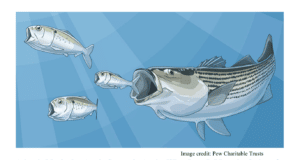People on boats disappear. Sometimes it’s accidental – they get knocked overboard or slip and splash after too many drinks. Sometimes it’s sinister – they’re pushed by a jealous lover or hijacked by bad guys.

vanished_1.jpg
Sometimes we just don’t know. And that’s what we have here – three unsolved cases of boaters gone missing with little in the way of clues left behind. Unfortunately, water doesn’t give up its mysteries by providing neat footprints or tire tracks. For those with murder on their minds, a boat is the perfect place. The only witnesses are the waves, and there’s a good chance the body will never be found. It’s not just killers who take advantage of the sea. For those who want to flee their old lives and morph into a new persona, a boat is a great place to fake your death. What follows are cases in which boaters simply vanished. Despite extensive investigations, they have yet to be found, either alive or dead. Whatever happened, the deep is holding its secrets tight.
Case #1: Lady in the Lake
Thirty-five year old Lana Stempien loved her boat, the 27′ Wellcraft cruiser Sea’s Life. She also loved her boyfriend, Chuck Rutherford. The combination would be her undoing. On August 10, 2005, the two took off in Sea’s Life from Lana’s parents’ house in Belle River, Ontario, across from Detroit, on a two-day vacation to Mackinac Island. By the first evening they were docked in Oscoda, Michigan, seen having cocktails at the Au Sable Inn and getting along fine. They were up early the next morning and at 12:30 p.m. stopped in Presque Isle to gas up. Lana called her aunt at 1:45 p.m., saying everything was fine. That was the last anyone heard from her. The next person to see the boat was Tom Behan on August 12.
Behan was in a 52′ express cruiser, 11 miles northeast of Mackinac, when he saw a much smaller boat having a hard time of it in rough weather. He approached and found Sea’s Life idling in neutral with the stereo on. There was no damage. Money was still there. Clothes were on deck. But the boat was empty.
For 26 hours, the Coast Guard searched some 2,600 square miles. Relatives rented airplanes, helicopters, and boats. No one found anything. Then, on August 24, Stempien’s body was spotted in Hammond Bay, Michigan, halfway between where the boat was found and where she had last checked in. She was wearing only a necklace, a ring, and her Omega watch. There was no sign of her boyfriend. The autopsy said Stempien had drowned. But she was no careless boater. As the daughter of a former U.S. Coast Guard officer, she was said to be overly safety conscious. So what happened?
One theory: Lana and Chuck went swimming and drowned. But according to her friend Andrew Jarvis, the water was a chilly 62 degrees. Besides, the swim ladder was up, and Lana would have taken off her jewelry. Then the toxicology report came back – there was a high level of carbon monoxide in her lungs. Could she have gone swimming behind the boat and breathed the exhaust? “That’s absolute rubbish,” says Jarvis. “If she had gone swimming, she knew to anchor the boat and not leave the motor running.” A more sinister question-was she thrown off?
The autopsy found no sign of foul play, but her running shoe was found lying on the boat with a knob from the boat’s GPS bracket wedged in the sole. Had there been a struggle? Another disturbing piece of evidence: The GPS was activated around 1:30 a.m., some 12 hours after anyone had heard from the couple. Could someone have been onboard, tampering with the device? According to Jarvis, 1,885 trackpoints out of 2,000 were used. What happened to the other 115? Were they erased? Was it a design defect?
Jarvis said the GPS is with the FBI, but preliminary tests he had done showed it was operating fine. Adding to the strangeness of the case is that the boater who found Sea’s Life, Tom Behan, said he saw a pair of blue fenders dragging 50′ from the boat when he came upon it. Stempien’s family said her fenders were white. Had there been another boat tied up to Sea’s Life?
It’s hard to say, especially because the Coast Guard didn’t indicate it had found the blue bumpers. Was there a lover’s tiff? Though the couple seemed to be getting along fine, some of Stempien’s friends said she was planning to end the relationship. And the last phone call she made from the boat was to another man, someone whom Rutherford had been jealous about in the past. Rutherford’s friends have said he’s not the type to kill. But he’s still missing, and the case remains open.
“We’ve contacted hydrologists at the University of Michigan,” says Major Barry Getzen of the Michigan State Police, “to see where someone might end up. We’re doing aerial searches. We’re doing sidescan sonar.” By exploring every angle, Getzen is trying not to form an opinion. “We’re trying to keep an open mind on several fronts.” Perhaps they’ll find the remains of Chuck Rutherford. Or perhaps he’s a murderer, hiding out somewhere. “There are lots of unanswered questions,” adds Jarvis. “Without enough resources, we’re simply not going to know.”
Case #2 Smuggler’s Blues
Roger Gamblin doesn’t think the government arranged for his friend of 30 years, Jim Trindade, to go missing. But he does think it knows something – and no one’s talking.
The 54-year-old Trindade had been crossing from Florida to the Bahamas since he was a kid. On January 12, 2006, he was heading back to Florida, this time in his new 38′ Donzi, which was used in the movie Miami Vice. With him were Gamblin’s son Chris, in his 35′ foot Donzi, and Chris’ friend Brian in a 22′ Angler. The three boats left Spanish Cay in the Bahamas around 9 a.m.
The three stopped in Grand Cay around 11:30 a.m. for lunch, then continued past Memory Rock, with Trindade in the lead. Around 2:20 p.m., Brian’s oil tank came loose. Chris stopped next to him and the two radioed Trindade, who said he’d wait for them.
But around 2:50 p.m., something happened. Chris and Brian heard Trindade on the radio: “U.S. Coast Guard. U.S. Coast Guard.” The boys couldn’t make contact but did manage to call Trindade’s wife, Candace, who got in touch with Roger Gamblin, who called two private planes to search the area.
Here’s where the government angle comes into play. Gamblin’s planes couldn’t take off right away-President Bush was in town and all planes were grounded until Air Force One left at 7:25 p.m. By then, only one of the planes could go up. That pilot searched 600 square miles in three hours. Coast Guard planes continued the search and at 1:09 a.m. spotted the Donzi, idling in circles, with no one onboard. Later, the Coast Guard reached the boat and found it out of gas. There were no obvious signs of foul play.
It’s possible Jim was knocked overboard by a wave, but that’s unlikely. Gamblin has another theory: “The boat was hijacked and used for smuggling,” he says. “Haitians, terrorists, who knows.” His rationale? The boat’s tanks were topped off-320 gallons-at Grand Cay. At 2:30 p.m. there was a waypoint put into the GPS; around that time, in that position, there should have been about 250 gallons left. If the boat had been idling from that point until it was found, 13 hours later, he estimates there would have been about 180 gallons left. But the tanks were bone dry. Meaning it must have been run for five or six hours at high speed. Hijackers, he says, could have taken it all the way to Freeport and brought it back to the same spot.
Government involvement grows thicker. Gamblin says a source told him there are satellite photos of Trindade’s boat being hijacked, but the NSA, FBI, and CIA have all been stonewalling him. He’s not sure why. “Someone’s watching three speedboats coming in fast when the president is taking off,” he says, “It’s all on satellite.” He’s thought about all kinds of possibilities, like maybe a terrorist attack that Trindade got in the middle of.
But so far there’s been no government cooperation. And Trindade’s body is still missing. The FBI is working the case, and Gamblin has three private detectives on it as well. He’s losing hope, but he hasn’t given up. He knows Jim would have done the same for him.
Case #3 The Improbable Journey
For 48-year-old divorcé Neil Wayne Eddleman, it was his weekend to spend with his son, 13-year-old Neil Alan Eddleman. Just a normal weekend…but one that would end in death and one of the largest Coast Guard searches in Florida history.
Neil Alan lived with his mother in Golden Gate, Florida, where his father picked him up for two days of fishing. The father and son left from Naples on October 17, 2003, with dad’s friend Gary Lisk aboard Lisk’s 24′ What’s Left. That was the last anyone saw of them. All that’s known is that the boat failed to return to Naples the following day. The Coast Guard went looking – a $1.6 million, 130,000-square-mile, week-long search – but found nothing.
Then, more than two weeks later, the boat-badly battered and out of gas – reappeared. But here’s the strange part: It showed up in Cape Canaveral, on the other side of the state, fully 550 miles away. Inside was Gary Lisk, his body too badly decomposed to determine a cause of death. There was no trace of either Eddleman.
Since then, Karen Eddleman, the mother of Neil Alan, has been trying to figure out what happened-and to find her son. “It’s a total nightmare,” she says. “The local police don’t do anything, and despite tons of requests to the FBI under the Freedom of Information Act, I can’t get them to release any details of their investigation.”
The local police feel that this was a boating accident. The boat was probably tied to a tower or some other structure, the rope broke during a storm, and Lisk was killed while the Eddlemans were washed out to sea. But Karen’s not so sure. Lisk supposedly left behind a float plan saying where he was going fishing. But Karen believes someone else wrote the plan after the fact, to make the Coast Guard look in the wrong place.
And she’s rightfully disturbed by the case’s biggest mystery-that the boat ended up on Florida’s east coast. “The boat would have had to steer itself through the Florida Keys,” she stresses.
What happened? Did the father run off with his son? “With his personality, it’s possible,” says Karen. And none of their possessions was found on the boat. But then $3,000 was found in the father’s home, which would probably come in handy when running away. Did the two get mixed up in something? Do they both have amnesia? Or are they at the bottom of the ocean?
The Eddlemans were declared dead in 2005, and Karen filed a wrongful death lawsuit against her ex-husband’s estate as well as that of Lisk’s, claiming the men were negligent for boating in inclement weather. The suit was settled for $300,000. But for Karen it doesn’t erase the agony of losing her son. She’s consulted numerous psychics, many of whom have said that her son is still alive. It’s a sliver of hope that Karen holds onto every day.









